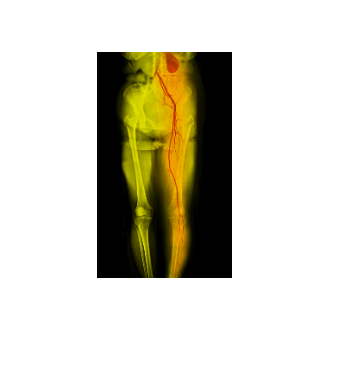Quick Overview
What is femoral vein and where is it located? The femoral vein is the main vein of the thigh. It drains blood from the lower leg and thigh and carries it back to the heart.
The femoral vein is located on the anterior surface of the thigh, deep to the fascia and subcutaneous tissue. It runs from the inguinal region to the popliteal fossa, where it becomes the popliteal vein.

Table of Contents
Anatomy of Femoral Vein
It is a large vein that is divided into two parts, i.e the superficial FV and the deep FV.
1- Superficial femoral vein: It is located on the anterior surface of the thigh, deep to the fascia and subcutaneous tissue. It runs from the saphenofemoral junction to the fossa ovalis, where it joins the deep femoral vein to form the common femoral vein.
2- Deep femoral vein: This vein is located deep to the fascia and muscles of the thigh. It runs from the popliteal fossa to the fossa ovalis, where it joins the superficial femoral vein to form the common femoral vein.
Location
It is located on the anterior surface of the thigh, deep to the fascia and subcutaneous tissue. It runs from the inguinal region to the popliteal fossa, where it becomes the popliteal vein.
Function
The primary function of this vein is to collect deoxygenated blood from the lower limb, including the thigh, calf, and foot. It serves as a conduit for transporting this blood towards the central venous circulation, ensuring efficient drainage and waste removal.
Branches
The branches include:
- Great saphenous vein: The great saphenous vein is the largest superficial vein of the body. It drains blood from the lower leg and thigh and empties into the femoral vein at the saphenofemoral junction.
- Small saphenous vein: The small saphenous vein is a superficial vein that drains blood from the lateral aspect of the leg and empties into the popliteal vein.
- Profunda femoris vein: The profunda femoris vein is a deep vein that drains blood from the muscles of the thigh and empties into the common femoral vein.
Clinical Importance
This vein holds a profound clinical importance, particularly in the context of medical procedures such as venous access, central venous catheter insertion, or diagnostic imaging.
Disorders and Treatment
- Deep vein thrombosis (DVT): DVT is a blood clot in a deep vein. It can be treated with blood thinners and compression stockings.
- Pulmonary embolism (PE): A PE is a blood clot that travels to the lungs. It can be treated with blood thinners and surgery.
- Femoral vein stenosis: It is the narrowing of the FV. It can be treated with angioplasty and stenting, or surgery.
Prevention
There are a number of things you can do to prevent FV disorder;
- Maintaining a healthy weight
- Exercising regularly
- Avoiding sitting or standing for long periods of time
- Wearing compression stockings if you are at high risk for DVT
Question
1. Where is the Femoral Vein?
It is located in the upper thigh region, typically beginning at the level of the groin crease and extending downward towards the lower extremity.
2. How to Find the Femoral Vein?
To locate the FV, you can start by identifying the groin crease (inguinal ligament) and palpating gently below it. The vein is usually found slightly beneath the skin surface in this area.
3. Where is the Femoral Vein Located?
This vein is located in the upper thigh, coursing through the femoral triangle, which is an anatomical region in the groin.
4. Which Vein Originates on the Medial Foot and Empties into the FV?
The Great Saphenous Vein is a major superficial vein that originates on the medial (inner) side of the foot and travels up the leg, eventually emptying into the FV in the groin region.
5. Where Does Blood Flow After It Leaves the Femoral Vein?
Blood leaving the FV continues its journey towards the central venous circulation. It typically enters larger veins such as the Inferior Vena Cava, eventually returning to the right atrium of the heart. From there, it is pumped to the lungs for oxygenation before being distributed to the rest of the body.
